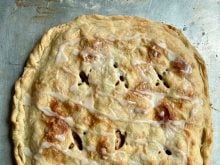“Spring is nature’s way of saying, ‘let’s party!'” – Robin Williams
After a long, cold winter, at last it is time to stop and breath the spring air.
The simplest things can bring us excitement: green colour popping through on the branches and under the grass, purple crocuses blooming and water trickling and filling ponds and puddles.
Then there’s the refreshing air. We all just want to get outside.
The frogs, meadow larks and geese come alive.
Don’t forget the rubber boots stuck in the mud, sailing boats in murky puddles and dirty wet laundry. And last but not least, we are usually presented with the usual spring pussy willow bouquet, which makes a lovely centrepiece for Easter gatherings.
Read Also

Support needed at all levels for high-value solar projects
Farmers, rural municipalities and governments should welcome any opportunity to get involved in large-scale solar power installations, say agrivoltaics proponents.
This year, I decided to find out more about Easter because I want my children to know that it is not just about chocolate, sleeping in and large rabbits.
Easter celebrates the central event of the Christian faith: the resurrection of Christ three days after his crucifixion. It is the oldest Christian holiday and the most important day of the church year.
The word Easter comes from Astarte, the Babylonian goddess of love and fertility. Astarte also became the Anglo-Saxon Ostara, goddess of fertility, spring and dawn. Easter was a pagan springtime celebration before it became a Christian holy day, and many non-religious elements form our celebrations.
Lent, the period that precedes Easter, is a period of fasting and atonement. It begins on Ash Wednesday, 40 days before Easter. At masses on this day, priests mark the foreheads of worshippers with ashes in the shape of a cross.
Eggs have long been a symbol of rebirth in many cultures, and the exchange of eggs at Easter is a popular custom among religious and secular observers of the holiday. The exchange of eggs is a custom that long predates Easter.
The white lily, the symbol of the resurrection, is the special Easter flower.
The Easter rabbit was first introduced to North America following the Civil War as the story of the resurrection of Christ became a source of renewed hope following the death and destruction of the war.
The rabbit first appeared as a symbol of Easter in 16th century Germany, and the first edible Easter bunnies were also produced in Germany during the early 1800s. German settlers later brought the custom to North America.
Originally, the hare was a pagan symbol of fertility and companion of the goddess Ostara.
Easter baskets originated from the Catholic custom of bringing Easter dinner food to mass to be blessed.
Palm Sunday celebrates the entry of Jesus into Jerusalem, where people spread palm branches and clothing before him. Maundy Thursday, or Holy Thursday, is the day to remember the Last Supper.
The world’s largest Easter egg, or pysanka, is located in Vegreville, Alta. It measures 9.4 metres high, seven metres long and 5.5 metres wide and weighs 2,270 kilograms.
The complex design, built of aluminum, sits on its base at a 30 degree angle.
The egg was created to commemorate the 100th anniversary of the Royal Canadian Mounted Police in 1974 and to celebrate Vegreville’s ethnic heritage. A large percentage of the town’s population is of Ukrainian Canadian descent.
Hot cross buns first popped up in England in 1733. The sweet, spicy yeast buns traditionally contain currants or raisins, and are marked on top by a cross (an X in the dough). They are traditionally eaten on Good Friday.
Source: Wikipedia
Roast lemon chicken & potatoes
Easter would not be complete without a delicious menu. Add a green salad and fresh bread.
1 roasting chicken (about 5 pounds/2.3 kg)
Salt and pepper to taste
2-3 teaspoons dried oregano, 10-15 mL
divided
4-6 baking potatoes,
peeled and quartered
4-6 carrots, peeled and quartered
1/4 cup butter, melted 60 mL
3 tablespoons fresh lemon juice 45 mL
3/4 cup chicken broth 175 mL
Place chicken breast side up on a rack in a roasting pan. Sprinkle with salt and pepper and half the oregano.
Arrange potatoes and carrots around the chicken; sprinkle with salt and pepper and the remaining oregano. Pour butter and lemon juice over chicken and vegetables. Add chicken broth to pan.
Bake uncovered at 350 F for 2 to 21/2 hours or until juices run clear and a meat thermometer inserted into thigh reads 180 F (82 C), basting frequently.
Cover and let stand for 10 minutes before carving. If desired, thicken pan drippings for gravy.
Yield: about 8-10 servings.
Roasted chicken will be juicier if you let it stand for about 10 minutes before carving.
Blueberry cheesecake
Finish off meals with spring colour. This berry no-cook cheesecake is pretty and tasty.
Crust
1/2 cup butter or margarine 125 mL
11/2 cups graham cracker crumbs 375 mL
1/2 teaspoon cinnamon 2 mL
1/4 teaspoon nutmeg 1 mL
Filling
8 oz cream cheese, softened 250 g
1 cup sugar 250 mL
1 tablespoon lemon juice 15 mL
1 cup dessert topping 250 mL or whipped cream
Blueberry topping
Frozen blueberries 600 g
or saskatoon berries
1/4 cup sugar 60 mL
2 tablespoons cornstarch 30 mL
Crust: Melt butter in saucepan over medium heat. Stir in crumbs. Press into nine by 13 inch (22 by 33 cm) pan. Bake in 350 F (180 C) oven for 10 minutes. Cool.
Filling: Beat cheese, sugar and lemon juice together to dissolve sugar. Prepare topping of your choice and fold into cheese mixture and spread over base. Chill.
Topping: In a saucepan over medium-high heat, bring berries and sugar to a boil, stirring often; reduce heat to medium and simmer until berries have softened and released their juices.
Stir cornstarch with two tablespoons (30 mL) of water until smooth; stirring berry mixture, pour cornstarch mixture into the pan. Simmer for 30 seconds, stir and remove from heat and let cool. Through fine sieve over a bowl, press half of the berry mixture, discarding the solids; stir into remaining berry mixture. Let cool.
Spoon cooled berry mixture over the top of the cheesecake and refrigerate until firm, about four hours, or up to a day.
Note: You can also use ready to use graham crust to save time.
Banana muffins & tart lemon icing
Try this recipe from Weight Watchers. For those of you are counting points, each muffin is worth three. They are like mini-frosted banana cakes with a surprising burst of lemon.
1/2 cup sugar 125 mL
5 tablespoons unsalted butter, 75 mL
softened
1 large egg
1 teaspoon vanilla extract 5 mL
2 cups all-purpose flour 500 mL
2 teaspoons baking powder 10 mL
1 teaspoon baking soda 5 mL
1/4 cup fat-free skim milk 60 mL
4 large bananas, ripe, mashed
Icing
1 cup powdered sugar 250 mL
1 tablespoon unsalted butter, 15 mL
softened
1 tbsp fresh lemon juice 15 mL
1 tsp lemon zest, strips, 5 mL or more to taste
1 tsp vanilla extract 5 mL
Preheat oven to 350 F (180 C). Line 18 muffin holes with paper liners.
Place sugar and butter in a large bowl; cream with an electric mixer until light and fluffy. Add egg and vanilla; beat until thoroughly mixed.
In another large bowl, mix together flour, baking powder and baking soda. Add half of flour mixture to butter mixture; beat well with mixer. Add milk and remaining flour mixture; beat until batter is combined and then fold in mashed bananas.
Spoon batter into muffin liners about three-quarters full. Bake until muffins start to brown and a tester inserted in centre of a muffin comes out clean, about 25 to 30 minutes.
Allow muffins to cool in pan for about two minutes; remove to a wire rack and cool completely before icing.
Meanwhile, combine icing ingredients in a medium bowl and beat with an electric mixer until creamy, one to two minutes. Ice cooled muffins; cover and refrigerate any uneaten muffins. Yields one muffin per serving.
Celebrate green
Every year on April 22, 500 million people from more than 180 countries participate in Earth Day. So many events have been organized that the entire month of April has become Earth Month.
Get involved by checking out what is happening in your area. If you must plan your own event, here are activity ideas to get you started:
* Garage sale or thrift store: You can recycle your unwanted stuff and help a local charitable business at the same time.
Community cleanup: Remove garbage from nature sites such as public parks or hiking trails to improve their appearance and protect your community’s wildlife.
* Nature hike: Getting fresh air and exercise will increase your appreciation of the environment and inspire you to do more to protect it.
* Plant a garden: Experience reaping what you sow. There is nothing like popping a fresh pod and eating the peas inside. Or picking a strawberry from your own garden. It is worth the effort.
* Plant a tree. This is my personal favourite because living on the Prairies, it is an activity that can really turn out to be a treasure in the future. The benefits of planting far outweigh the effort that it takes to grow a tree.
Jodie Mirosovsky is a home economist from Rosetown, Sask., and one of four columnists comprising Team Resources. Send correspondence in care of this newspaper, Box 2500, Saskatoon, Sask., S7K 2C4 or contact them at team@producer.com.














